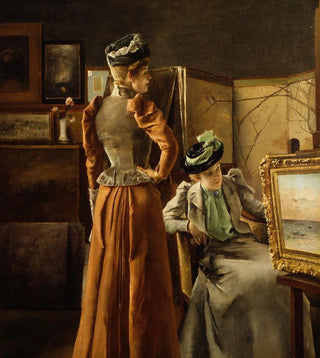Art print Watching a painting - Alfred Stevens


View from behind

Frame (optional)
Art print Watch a painting - Alfred Stevens – Engaging introduction
In the vast panorama of art history, certain works manage to capture the very essence of artistic contemplation. "Watch a painting" by Alfred Stevens is one of those iconic pieces that transcends the simple act of observation. This piece invites the viewer to immerse themselves in a universe where the gaze becomes a tool of interpretation and emotion. Through the depiction of a moment of introspection, Stevens succeeds in establishing a dialogue between the subject and the artwork, an interaction that resonates deeply with anyone who has ever lost themselves in the contemplation of art. The scene, imbued with subtle delicacy, reminds us that each painting has its story, its message, and that it only awaits discovery.
Style and uniqueness of the work
Alfred Stevens's style is characterized by a refined approach and meticulous attention to detail. In "Watch a painting," the artist deploys a palette of soft colors, creating an intimate atmosphere that envelops the viewer. Light plays a crucial role, illuminating faces and textures, while shadows add a dimension of depth and mystery. The composition is carefully orchestrated, with each element placed with precision that reflects Stevens's craftsmanship. This artwork is not merely a depiction of a moment; it is a celebration of art itself, an invitation to appreciate the beauty that resides in attentive observation. The way the characters interact with the piece they are contemplating underscores the importance of art in daily life, transforming a simple instant into a rich aesthetic experience.
The artist and his influence
Alfred Stevens, born in Brussels in 1823, is often regarded as one of the masters of realism in the 19th century. His artistic journey led him to explore various themes, but it is the depiction of bourgeois life and genre scenes that earned him international recognition. Stevens was able to capture the essence of his era, blending elegance and sensitivity in his works. His influence extends beyond his own work, inspiring generations of artists to question the relationship between art and life. By incorporating elements of popular culture and showing interest in

Matte finish

View from behind

Frame (optional)
Art print Watch a painting - Alfred Stevens – Engaging introduction
In the vast panorama of art history, certain works manage to capture the very essence of artistic contemplation. "Watch a painting" by Alfred Stevens is one of those iconic pieces that transcends the simple act of observation. This piece invites the viewer to immerse themselves in a universe where the gaze becomes a tool of interpretation and emotion. Through the depiction of a moment of introspection, Stevens succeeds in establishing a dialogue between the subject and the artwork, an interaction that resonates deeply with anyone who has ever lost themselves in the contemplation of art. The scene, imbued with subtle delicacy, reminds us that each painting has its story, its message, and that it only awaits discovery.
Style and uniqueness of the work
Alfred Stevens's style is characterized by a refined approach and meticulous attention to detail. In "Watch a painting," the artist deploys a palette of soft colors, creating an intimate atmosphere that envelops the viewer. Light plays a crucial role, illuminating faces and textures, while shadows add a dimension of depth and mystery. The composition is carefully orchestrated, with each element placed with precision that reflects Stevens's craftsmanship. This artwork is not merely a depiction of a moment; it is a celebration of art itself, an invitation to appreciate the beauty that resides in attentive observation. The way the characters interact with the piece they are contemplating underscores the importance of art in daily life, transforming a simple instant into a rich aesthetic experience.
The artist and his influence
Alfred Stevens, born in Brussels in 1823, is often regarded as one of the masters of realism in the 19th century. His artistic journey led him to explore various themes, but it is the depiction of bourgeois life and genre scenes that earned him international recognition. Stevens was able to capture the essence of his era, blending elegance and sensitivity in his works. His influence extends beyond his own work, inspiring generations of artists to question the relationship between art and life. By incorporating elements of popular culture and showing interest in
12,34 €






